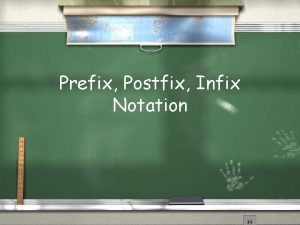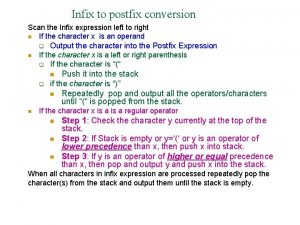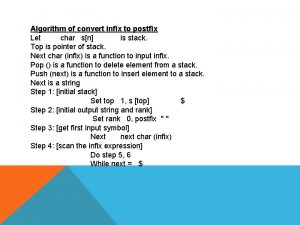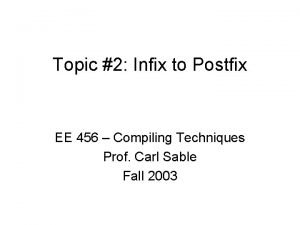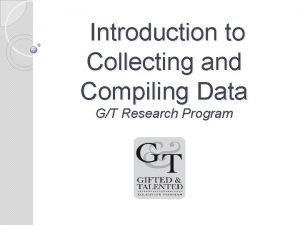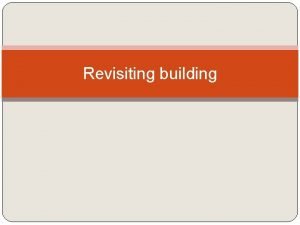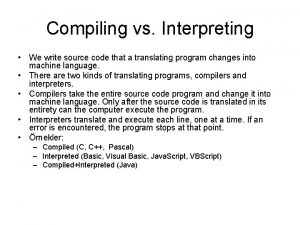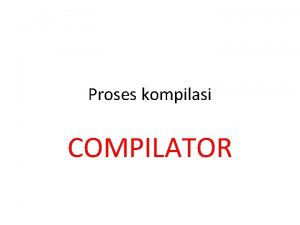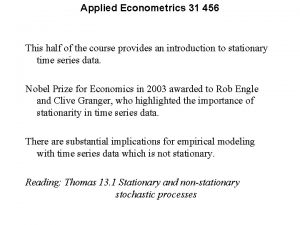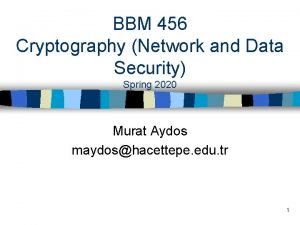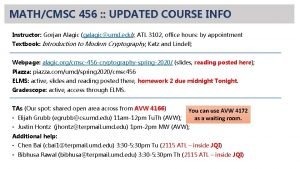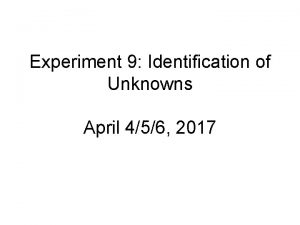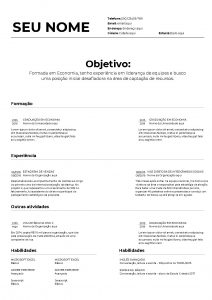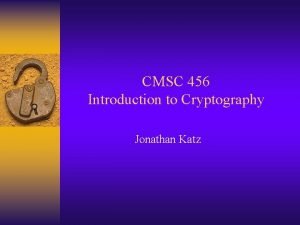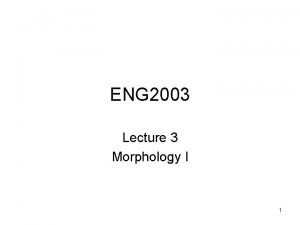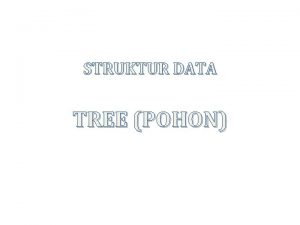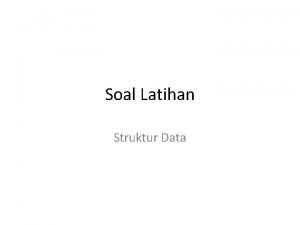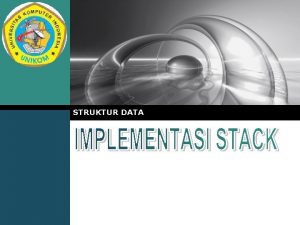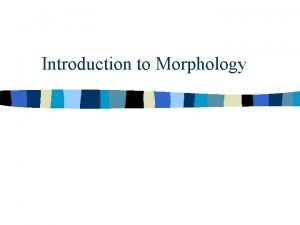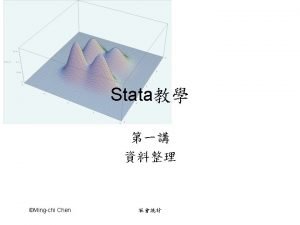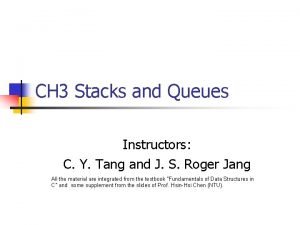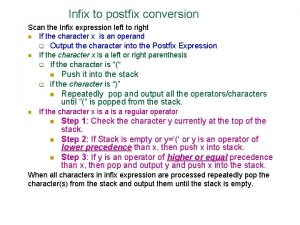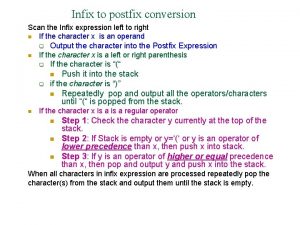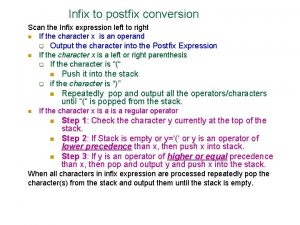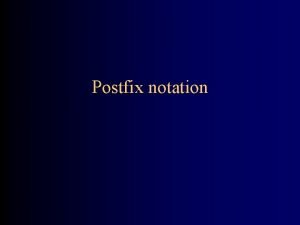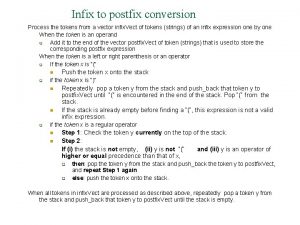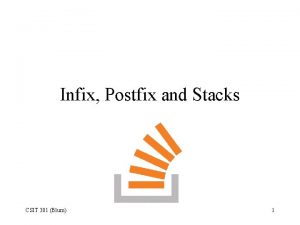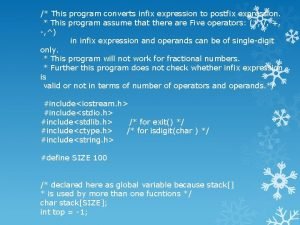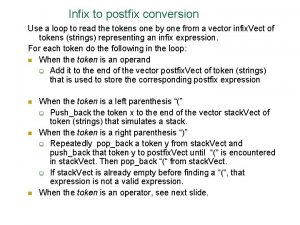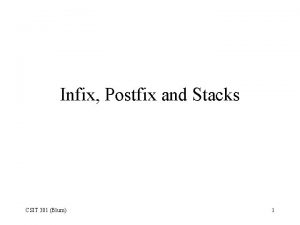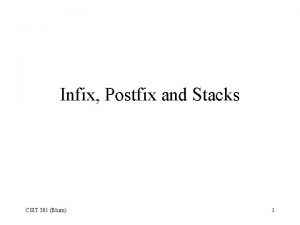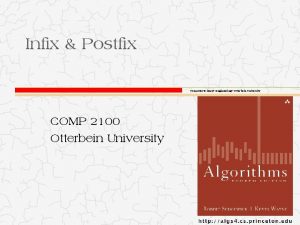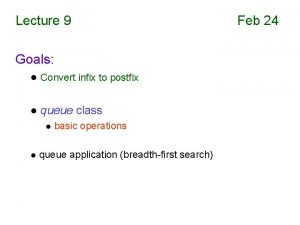Topic 2 Infix to Postfix EE 456 Compiling













































- Slides: 45

Topic #2: Infix to Postfix EE 456 – Compiling Techniques Prof. Carl Sable Fall 2003

Why this topic? • Program to convert infix to postfix – A simple, one-pass compiler! – Infix notation is source language – Postfix is intermediate code – No code generation (but could be actions) • A good example that introduces many aspects of writing a compiler

Syntax vs. Semantics • Syntax – Describes what is allowable in a language – Relatively easy to describe (we will use context free grammars) • Semantics – Describes the meaning of a program (or expression) – Very difficult to describe in a formal sense • We are discussing programming languages, but these definitions also apply to natural languages

Structure of Simple Compiler • A lexical analyzer will tokenize the input • A “syntax-directed translator” combines syntax analysis and intermediate code generation

Context-free Grammars • Often used to describe the hierarchical structure of a programming language • Every CFG has four components: – A set of tokens (terminal symbols) – A set of nonterminals – A set of productions (rules) – A start symbol (left side of first rule) Example rule: stmt → if (expr) stmt else stmt

Productions • Every production consists of left side, an arrow (“can have the form of”), right side • Left side is a always nonterminal; the production is “for” this nonterminal • Right side consists of terminals and/or non -terminals • Convention, nonterminals will be italicized Example rule: stmt → if (expr) stmt else stmt

Example CFG • List of digits separated by plus or minus signs: list → list + digit list → list – digit list → digit → 0 | 1 | 2 | 3 | 4 | 5 | 6 | 7 | 8 | 9 • For convenience, nonterminals can be grouped using ‘|’ (“or”) list → list + digit | list – digit | digit → 0 | 1 | 2 | 3 | 4 | 5 | 6 | 7 | 8 | 9 • The tokens of this grammar: + • The start symbol: list - 0 1 2 3 4 5 6 7 8 9

CFG for Expressions expr → expr + term | expr – term | term → term * factor | term / factor | factor → digit | (expr) digit → 0 | 1 | 2 | 3 | 4 | 5 | 6 | 7 | 8 | 9

Strings • A string of tokens is a sequence of zero or more tokens • The string containing zero tokens is the empty string: ‘ε’ • A grammar “derives” strings – starting with start symbol – repeatedly replacing nonterminals with right side of productions for the nonterminals – The set of strings that can be derived from the start symbol is the “language” for the grammar

Parse Trees • Shows how the start symbol of a grammar can derive a string in the language • A tree with the following properties: – – The root is labeled with a start symbol Each leaf labeled with a token or ε Each interior node is labeled by a nonterminal If A is the label for an interior node, and X 1, X 2, …, Xn (nonterminals or tokens) are the labels of its children, then the following production must exist: A → X 1 X 2 … Xn

Sample Parse Tree: 9 – 5 + 2

More on Parse Trees • A language can be defined as all strings that can be generated by some parse tree • The process of finding a parse tree for a given string is called “parsing” the string

Ambiguous Grammars • If any string has more than one parse tree, grammar is said to be ambiguous • Need to avoid for compilation, since string can have more than one meaning • List of digits separated by plus or minus signs: string → string + string | string – string |0 | 1 | 2 | 3 | 4 | 5 | 6 | 7 | 8 | 9 • Example merges notion of digit and list into single nonterminal string • Same strings are derivable, but some strings have multiple parse trees (possible meanings)

Two Parse Trees: 9 – 5 + 2

Precedence and Associativity • Precedence – Determines the order in which different operators are evaluated when they occur in the same expression – Operators of higher precedence are applied before operators of lower precedence • Associativity – Determines the order in which operators of equal precedence are evaluated when they occur in the same expression – Most operators have a left-to-right associativity, but some have right-to-left associativity

Postfix Notation • Formal rules, infix → postfix – If E is variable or constant, E → E – If E is expression of form E 1 op E 2, where op is binary operator, E 1 → E 1’, and E 2 → E 2’, then E → E 1’ E 2’ op – If E is expression of form (E 1) and E 1 → E 1’, then E → E 1’ • Parentheses are not needed!

Syntax-Directed Definitions • CFG to specify syntactic structure of input • Each grammar symbol has associated attributes • Each production has associated semantic rules for computing values of attributes • Grammar and semantic rules together constitute the syntax-directed definition • A parse tree showing the attribute values at each node is called an annotated parse tree

Two Types of Attributes • Synthesized Attributes – Value at a parse-tree node can be determined based on values of attributes of children – Can be evaluated during a single bottom-up traversal of parse tree • Inherited Attributes – More complicated – Will be discussed later in course

Example Syntax-Directed Definition Production Semantic Rule expr 1 + term expr. t : = expr 1. t || term. t || ‘+’ expr 1 - term expr. t : = expr 1. t || term. t || ‘-’ expr term expr. t : = term. t term 0 term. t : = ‘ 0’ term 1 term. t : = ‘ 1’ … term 9 … term. t : = ‘ 9’

Depth-First Search • Recursively visit all children before evaluating semantic rules of given node • Suitable if all attributes are synthesized procedure visit (n: node) begin for each child m of n, from left to right do visit(m) evaluate semantic rules at node n end

Annotated Parse Tree: 9 – 5 + 2

Translation Schemes • Adds to a CFG • Includes “semantic actions” embedded within productions • Similar to syntax-directed definition, but order of evaluation is explicit

Example Translation Scheme expr term expr + term { print(‘+’) } expr – term { print(‘-’) } term 0 { print(‘ 0’) } 1 { print(‘ 1’) } … term 9 { print(‘ 9’) }

Equivalent Translation Scheme expr rest term term rest + term { print(‘+’) } rest - term { print(‘-’) } rest ε 0 { print(‘ 0’) } 1 { print(‘ 1’) } … term 9 { print(‘ 9’) }

Parsing • Parsing is the process of determining if a string of tokens can be generated by a grammar • For any CFG, there is a parser that takes at most O(n^3) time • For most programming languages that arise in practice, linear time parsers exist

Top-down Parsing • Recursively apply the following steps: – At node n with nonterminal A, select a production for A – Construct children at n for symbols on right side of selected production – Find next node for which subtree needs to be constructed • Top-down parsing uses a “lookahead” symbol • Selecting production may involve trial-and-error and backtracking

Predictive Parsing • Recursive-descent parsing is a recursive, top-down approach to parsing • A procedure is associated with each nonterminal of the grammar • Predictive parsing – Special case of recursive-descent parsing – The lookahead symbol unambiguously determines the procedure for each nonterminal

Procedures for Nonterminals • Production with right side α used if lookahead is in FIRST(α) – FIRST(α) is set of all symbols that can be first symbol of α – If lookahead symbol is not in FIRST set for any production, can use production with right side of ε – If two or more possibilities, can not use this method – If no possibilities, an error is declared • Nonterminals on right side of selected production are recursively expanded

Left Recursion • Left-recursive productions can cause recursive-descent parsers to loop forever • Example: example + term • Can eliminate left recursion A Aα|β A βR R αR|ε

Eliminating Left Recursion expr term expr rest term expr + term { print(‘+’) } expr – term { print(‘-’) } term 0 { print(‘ 0’) } 1 { print(‘ 1’) } … term 9 { print(‘ 9’) } term rest + term { print(‘+’) } rest - term { print(‘-’) } rest ε 0 { print(‘ 0’) } 1 { print(‘ 1’) } … term 9 { print(‘ 9’) }

Infix to Prefix Code: Part 1 #include <stdio. h> #include <ctype. h> int lookahead; void void expr(void); rest(void); term(void); match(int); error(void); int main(void) { lookahead = getchar(); expr(); putchar('n'); /* adds trailing newline character */ } …

Infix to Prefix Code: Part 2 … void expr(void) { term(); rest(); } void term(void) { if (isdigit(lookahead)) { putchar(lookahead); match(lookahead); } else error(); } …

Infix to Prefix Code: Part 3 … void rest(void) { if (lookahead == '+') { match('+'); term(); putchar('+'); rest(); } else if (lookahead == '-') { match('-'); term(); putchar('-'); rest(); } } …

Infix to Prefix Code: Part 4 … void match(int t) { if (lookahead == t) lookahead = getchar(); else error(); } void error(void) { printf("syntax errorn"); /* print error message */ exit(1); /* then halt */ }

Code Optimization 1 void rest(void) { REST: if (lookahead == '+') { match('+'); term(); putchar('+'); goto REST; } else if (lookahead == '-') { match('-'); term(); putchar('-'); goto REST; } }

Code Optimization 2 void expr(void) { term(); while (1) { if (lookahead == '+') { match('+'); term(); putchar('+'); } else if (lookahead == '-') { match('-'); term(); putchar('-'); } else break; } }

Improvements Remaining • • Want to ignore whitespace Allow numbers Allow identifiers Allow additional operators (multiplications and division) • Allow multiple expressions (separated by semicolons)

Lexical Analyzer • Eliminates whitespace (and comments) • Reads numbers (not just single digits) • Reads identifiers and keywords

Implementing the Lexical Analyzer

Allowable Tokens • expected tokens: +, -, *, /, DIV, MOD, (, ), ID, NUM, DONE • ID represents an identifier, NUM represents a number, DONE represents EOF

Tokens and Attributes LEXEME white space TOKEN ATTRIBUTE VALUE --- sequence of digits NUM numeric value of sequence div DIV --- mod MOD --- letter followed by letters and digits ID EOF DONE any other character that character index into symbol table --NONE

A Simple Symbol Table • Each record of symbol table contains a token type and a string (lexeme or keyword) • Symbol table has fixed size • All lexemes in array of fixed size • Will be able to insert and search for tokens: – insert(s, t): creates entry with string s and token t, returns index into symbol table – lookup(s): searches for entry with string s, returns index if found, 0 otherwise • Keywords (div and mod) will be inserted into symbol table, they can not be used as identifiers

Updated Translation Scheme start list eof list expr; list | ε expr + term { print(‘+’) } | expr – term { print(‘-’) } | term * factor { print(‘*’) } | term / factor { print(‘/’) } | term div factor { print(‘DIV’) } | term mod factor { print(‘MOD’) } | factor (expr) | id { print(id. lexeme) } | num { print(num. value) }

After Eliminating Left Recursion start list eof list expr; list | ε expr term moreterms + term { print(‘+’) } moreterms | - term { print(‘-’) } moreterms | ε term factor morefactors * factor { print(‘*’) } morefactors | / factor { print(‘/’) } morefactors | div factor { print(‘DIV’) } morefactors | mod factor { print(‘MOD’) } morefactors | ε factor (expr) | id { print(id. lexeme) } | num { print(num. value) }

Final Code • About 250 lines of C • Pretty sloppy, otherwise would be longer
 Polish prefix
Polish prefix Infix equation
Infix equation Infix prefix postfix
Infix prefix postfix Infix to postfix in c
Infix to postfix in c Algorithm for infix to postfix conversion
Algorithm for infix to postfix conversion Infix to postfix converter
Infix to postfix converter Compiled data in research
Compiled data in research Compiling creates an
Compiling creates an Compiling information
Compiling information Compiling vs interpreting
Compiling vs interpreting An integral part planning and compiling a calendar is
An integral part planning and compiling a calendar is Fase fase proses kompilasi
Fase fase proses kompilasi Thoughts compiling
Thoughts compiling A clincher sentence is
A clincher sentence is Broad topic and specific topic examples
Broad topic and specific topic examples Half of 456
Half of 456 Bbm 456
Bbm 456 888-456-7910
888-456-7910 123456789 xxxx
123456789 xxxx 456 name
456 name Slump value as per is 456
Slump value as per is 456 Gcs 456
Gcs 456 123 456 78
123 456 78 Write a number in expanded form. 456
Write a number in expanded form. 456 One way slab design example as per is 456
One way slab design example as per is 456 Concrete mix ratio 1:2:3
Concrete mix ratio 1:2:3 Gcs 456
Gcs 456 8004563355
8004563355 123 + 456 + 789
123 + 456 + 789 123-456-7890
123-456-7890 Roland purcell a technical writer
Roland purcell a technical writer Cmsc 456 3 cryptology
Cmsc 456 3 cryptology Gbc gang oklahoma city
Gbc gang oklahoma city Identification test for esters
Identification test for esters 123 + 456 x 789
123 + 456 x 789 Cmsc 456
Cmsc 456 Give 10 examples of infix
Give 10 examples of infix Cafeteria stack
Cafeteria stack Binar tree
Binar tree Dari gambar ini, maka notasi infix yang dihasilkan adalah :
Dari gambar ini, maka notasi infix yang dihasilkan adalah : Logo notasi
Logo notasi What is inflectional and derivational morphology
What is inflectional and derivational morphology Stata infix
Stata infix Postfix expression 5 4 6 + * 4 9 3 / + *
Postfix expression 5 4 6 + * 4 9 3 / + * Postfix expression
Postfix expression Solve the given postfix expression. 62-3+4*
Solve the given postfix expression. 62-3+4*


